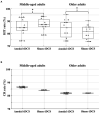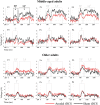Opposite pattern of transcranial direct current stimulation effects in middle-aged and older adults: Behavioral and neurophysiological evidence
- PMID: 36761183
- PMCID: PMC9905246
- DOI: 10.3389/fnagi.2023.1087749
Opposite pattern of transcranial direct current stimulation effects in middle-aged and older adults: Behavioral and neurophysiological evidence
Abstract
Introduction: Episodic memory (EM) exhibits an age-related decline, with overall increased impairment after the age of 65. The application of transcranial direct current stimulation (tDCS) to ameliorate cognitive decline in ageing has been extensively investigated, but its efficacy has been reported with mixed results. In this study, we aimed to assess whether age contributes to interindividual variability in tDCS efficacy.
Methods: Thirty-eight healthy adults between 50 and 81 years old received anodal tDCS over the left prefrontal cortex during images encoding and then performed an EM recognition task while event-related potentials (ERPs) were recorded.
Results: Our results showed an opposite pattern of effect between middle-aged (50-64 years) and older (65-81 years) adults. Specifically, performance in the recognition task after tDCS was enhanced in older adults and was worsened in middle-aged adults. Moreover, ERPs acquired during the recognition task showed that two EM components related to familiarity and post-retrieval monitoring, i.e., Early Frontal and Late Frontal Old-New effects, respectively, were significantly reduced in middle-aged adults after anodal tDCS.
Discussion: These results support an age-dependent effect of prefrontal tDCS on EM processes and its underlying electrophysiological substrate, with opposing modulatory trajectories along the aging lifespan.
Keywords: aging; dorsolateral prefrontal cortex; episodic memory; event-related potentials; transcranial direct current stimulation.
Copyright © 2023 Bagattini, Cid-Fernández, Bulgari, Miniussi and Bortoletto.
Conflict of interest statement
The authors declare that the research was conducted in the absence of any commercial or financial relationships that could be construed as a potential conflict of interest.
Figures



References
-
- Antal A., Alekseichuk I., Bikson M., Brockmöller J., Brunoni A. R., Chen R., et al. . (2017). Low intensity transcranial electric stimulation: safety, ethical, legal regulatory and application guidelines. Clin. Neurophysiol. 128, 1774–1809. doi: 10.1016/j.clinph.2017.06.001, PMID: - DOI - PMC - PubMed
LinkOut - more resources
Full Text Sources

